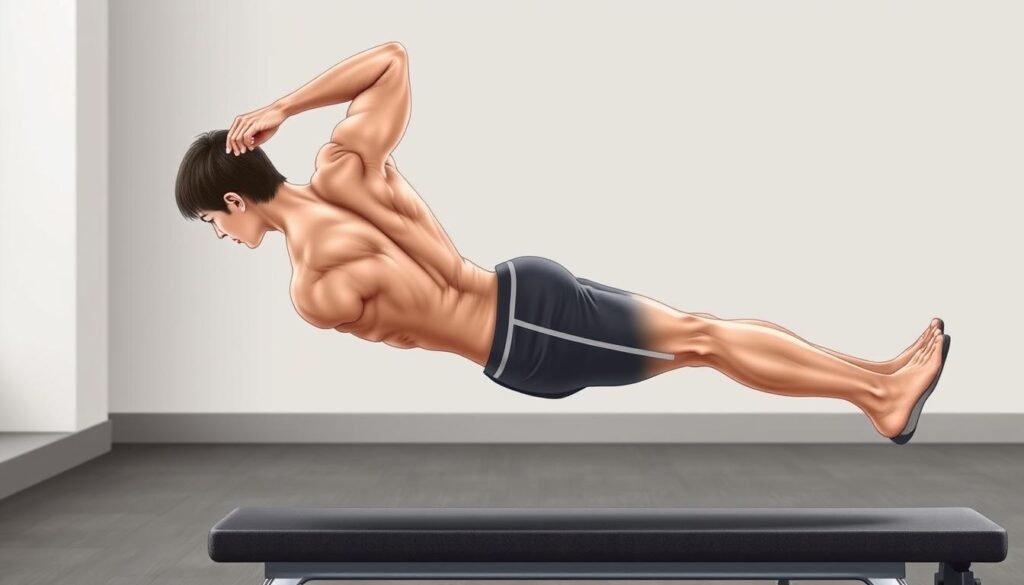I’ve dealt with chronic back pain and know how it limits our lives. But, I’ve also found relief in strengthening my back muscles. Today, I want to share a guide to help you build a stronger back. This will not only ease pain but also boost your fitness and well-being.
Back pain affects four out of five adults at some point. This shows how vital it is to include back-strengthening exercises in our routines. Whether you’re into weightlifting, yoga, or just want better posture, this guide has what you need. It will help you achieve a stronger, more resilient back.

Key Takeaways:
- Back exercises are key for fitness and health. They improve posture, reduce injury risk, boost lifts, and create a V-shape physique.
- Strengthening the spine, shoulders, and core through back exercises can ease lower back pain. This is a common issue for many.
- Using a mix of equipment and bodyweight exercises targets the back muscles well.
- It’s crucial to focus on proper form and technique in back exercises. Gradually increasing intensity and volume leads to significant strength gains.
- Don’t forget to warm up, rest, and recover properly for an effective back workout routine.
Understanding Back Muscle Anatomy and Function
The back is made up of many muscles that work together. They provide stability, support, and help us move. Knowing about these muscles is key to understanding why back exercises are important.
Primary Back Muscles and Their Roles
The back muscles can be divided into three groups: superficial, intermediate, and intrinsic. The superficial muscles, like the trapezius and latissimus dorsi, help with arm and shoulder movements. The intermediate muscles, such as the serratus posterior, help stabilize the rib cage and spine.
The intrinsic muscles, including the erector spinae, are deep and important. They help keep our posture right and support the spine.
Benefits of Back Strengthening
Strengthening the back muscles has many benefits. It improves our posture, reduces injury risk, and makes us look better. A good workout routine can make our back stronger and more flexible.
Common Back Problems and Solutions
Back problems are common, like lower back pain and stiffness. But, many can be fixed with the right exercises and stretches. Knowing the causes and using the right strategies can help prevent these issues.
“Strengthening the back muscles is crucial for maintaining a healthy and functional body, as they are responsible for supporting the spine and enabling a wide range of movements.”
Exercises for a Stronger Back
Having a strong back is key for fitness, posture, and avoiding back pain. Our guide covers back exercises for different muscle groups. These exercises help build a strong back that supports your daily activities.
Some key back exercises we suggest include:
- Barbell Bent-Over Rows
- Kettlebell Swings
- Barbell Deadlifts
- Pull-Ups
- Dumbbell Single-Arm Rows
- Chest-Supported Dumbbell Rows
- Inverted Rows
- Lat Pulldowns
- T-Bar Rows
These back workouts focus on both lower back exercises and upper back exercises. They help strengthen and tone your back muscles. Mixing these exercises in your routine is a great way to train your back fully.
| Exercise | Targeted Muscles | Recommended Reps |
|---|---|---|
| Resistance Band Pull-Apart | Traps, Rhomboids | 1–3 sets of 8–12 reps |
| Lat Pulldown | Lats | 1–3 sets of 8–12 reps |
| Back Extension | Erector Spinae | 1–3 sets of 8–12 reps |
| Suspended Row | Lats, Biceps | 1–3 sets of 8–12 reps |
| Wood Chop | Core, Upper Back | 1–3 sets of 8–12 reps per side |
| Good Morning | Hamstrings, Lower Back | 1–3 sets of 8–12 reps |
| Quadruped Single-Arm Dumbbell Row | Lats, Upper Back | 1–3 sets of 8–12 reps per side |
| Wide Dumbbell Bent-Over Row | Lats, Rhomboids | 1–3 sets of 8–12 reps |
The Barbell Deadlift is a key exercise that works many muscles, including the back. It requires a lot of back strength to do right.

“A strong back is the foundation for a healthy and active lifestyle. Incorporating these exercises into your routine can help alleviate back pain and improve overall posture and function.”
Essential Equipment for Back Training
To get a strong, sculpted back, you need the right gear. This is true whether you’re at the gym or working out at home. Let’s look at the key equipment that can boost your back exercises and help you meet your fitness goals.
Gym Equipment Options
At a well-equipped gym, you have many options for back training. Barbells, dumbbells, and cable machines are versatile tools for targeting back muscles. Pull-up bars, found in most gyms, are great for bodyweight exercises that strengthen the upper back and lats.
Home Workout Alternatives
Working out at home? No worries. There are many effective back exercise equipment choices. Resistance bands are a convenient, portable option for adding resistance to your back workouts. You can also do bodyweight exercises like inverted rows using a table or desk. Even household items like towels or water bottles can be used as makeshift tools for back exercises.
Resistance Band Selection
Choosing the right resistance bands for back is important. Look for a set with different tensions to match your workout needs. This variety will help you challenge your muscles and improve your back strength over time.
Whether you’re at the gym or working out at home, the right back exercise equipment is crucial. By using a mix of gym tools and creative home workouts, you’ll be on your way to achieving the back you’ve always wanted.

Proper Form and Technique Guidelines
Getting a stronger, healthier back starts with learning the right form and technique for your exercises. It’s important to keep your spine straight, engage your core, and move in a controlled way. This helps you work your muscles better and avoid injuries during back workouts.
When you do rowing exercises, pull with your elbows close to your body. This targets the lats and reduces strain on your shoulders. For deadlifts and good mornings, bend at the hips and keep your back straight. This engages the muscles in your back properly. Also, breathing correctly, like exhaling when you exert, can improve your performance and muscle use.
Always focus on form over weight. Using bad technique, even with light weights, can cause serious injuries. It can also make your exercises less effective. Spend time getting your form right, and you’ll see a stronger, more durable back.

“Proper form is the foundation for building a strong, healthy back. Prioritize technique over weight to maximize muscle engagement and prevent injuries.”
By following these proper lifting technique tips, you’ll see better results from your back exercise form. You’ll also lower your risk of injury prevention exercises. Learning the basics is crucial for a lasting and effective back-strengthening routine.
Bodyweight Back Exercises for Beginners
Building a strong back doesn’t need fancy gym gear. You can do some of the best bodyweight back exercises at home with little to no equipment. These beginner back workouts are great for newbies, helping build the base strength and stability for more complex moves.
Superman Holds
The Superman hold is a classic no-equipment back exercise that targets the back muscles. Lie face-down on the floor with arms extended and legs straight. Lift your arms, chest, and legs off the ground, forming a “Superman” shape. Hold for 2-3 seconds, then lower back down. Do 12-15 reps.
Bird Dogs
The bird dog exercise strengthens the core and improves balance. Start on hands and knees, then extend your opposite arm and leg. Hold for a moment, then switch sides. Do 10-12 reps per side, keeping your core tight.
Inverted Rows
Inverted rows are a top bodyweight back exercise that uses a sturdy table or bar. Grip the edge with hands wider than shoulder-width apart. Row your chest up, squeezing your shoulder blades together at the top. Slowly lower back down and repeat for 8-10 reps.
These beginner back workouts are perfect for starting a back-strengthening routine without expensive gym equipment. Add 2-3 of these exercises to your weekly routine. You’ll be on your way to a healthier, more balanced body in no time.
Advanced Back Strengthening Movements
Advanced exercises are key to a stronger back. They help us grow stronger and more resilient. This is important for our overall fitness and health.
Weighted pull-ups are a great example. They work the back, biceps, shoulders, and core. It’s a full-body workout that requires a lot of strength.
The barbell row is another effective exercise. It targets the back and engages other muscles. It’s important to keep the spine straight and pull the bar to your chest.
The deadlift is also crucial. It works the entire back and legs. With the right form and weight, it can greatly improve back strength.
Using drop sets, supersets, or time under tension can also help. These methods push us harder and help our back muscles grow stronger.
Always focus on proper form and start slow. Rushing can cause injuries. Be patient, consistent, and make sure to recover well to get the most out of these exercises.
| Exercise | Muscles Targeted | Benefits |
|---|---|---|
| Weighted Pull-ups | Lats, Traps, Biceps, Core | Comprehensive upper body strength, improved grip strength |
| Barbell Rows | Lats, Traps, Rhomboids | Increased back muscle activation, improved posture |
| Deadlifts | Lower Back, Glutes, Hamstrings | Tremendous core and posterior chain strength, enhanced functional fitness |
Remember, as we explore these advanced back exercises, it’s crucial to prioritize proper form and gradual progression. Rushing into too much too soon can lead to injury and setbacks. Patience, consistency, and a focus on recovery are key to unlocking the full benefits of these powerful movements.
Creating an Effective Back Workout Routine
Having a strong back is key for good upper body strength and posture. We need a back workout routine that covers all muscle groups. This mix of exercises will strengthen and shape your back from top to bottom.
Weekly Training Schedule
Train your back 2-3 times a week. Make sure to rest for 48-72 hours between workouts. This rest helps your muscles grow and prevents injury.
Progressive Overload Principles
Use progressive overload in your back workouts. Increase the weight, reps, or sets slowly. This keeps your muscles challenged and helps them grow stronger.
Rest and Recovery Tips
- Rest for 1-2 minutes between sets. This lets your muscles recover before the next exercise.
- Do mobility and stretching exercises to keep your back flexible and prevent stiffness.
- Focus on good nutrition, hydration, and sleep to help your muscles recover and grow.
By following these tips, you’ll be on your way to a stronger, more impressive back.

Preventing Injuries During Back Training
Keeping our back healthy and injury-free is key for a good workout. When we strengthen our back muscles, using the right form is crucial. This helps avoid injuries. By taking a few simple steps, we can safely build a stronger back.
First, always warm up before starting back exercises. Doing dynamic stretches and core exercises gets our body ready. This reduces the chance of injury. Then, keep the right form during each exercise to avoid back strain.
Strengthening our core is also important for injury prevention. Our core muscles support and stabilize our back. By working these muscles, we improve our spinal health and lower injury risk.
It’s important to listen to our body and stop if we feel pain. If we have sharp or ongoing pain, it’s time to stop. Gradually increasing the weight helps our back muscles adapt safely.
By focusing on warm-ups, proper form, core strength, and listening to our body, we can train our back safely. These steps help us reach our fitness goals without harming our back.
| Injury Prevention Strategies | Benefits |
|---|---|
| Thorough warm-up with dynamic stretches and activation exercises | Prepares the body for the upcoming workout, reducing the risk of strains or sprains |
| Maintaining correct exercise form | Avoids excessive arching or rounding of the back, minimizing stress on the spine |
| Strengthening the core muscles | Provides crucial support and stability for the back during exercises, enhancing overall spinal health |
| Gradually progressing in weight and intensity | Allows the back muscles to adapt safely, preventing overuse injuries |
| Listening to your body and avoiding pain | Stops the exercise before a potential injury occurs, enabling proper recovery and healing |
By using these injury prevention strategies, we can build a stronger back safely. This approach not only boosts our workout but also improves our overall well-being.
Conclusion
Regular back workouts bring many benefits. These include better posture, less pain, and improved sports skills. They also help achieve a balanced body shape.
By doing different back exercises and focusing on correct form, we can strengthen our back fully. A strong back is key for daily tasks and overall health. It lowers injury risks and boosts our well-being.
Sticking to a back workout plan is key for lasting back strengthening benefits. You can choose from simple bodyweight exercises to more complex ones. The important thing is to keep going and adjust your routine as needed.
This way, you build a stronger, more durable body. It will support you in all physical activities and help improve your overall fitness improvement.
Working on a stronger back is a smart investment in your health. It leads to better posture, less pain, and more confidence in your body. So, take on the challenge, stay committed, and see your back become a strong base for a healthier you.
FAQ
What are the primary back muscles and their functions?
The main back muscles are the latissimus dorsi, rhomboids, trapezius, and erector spinae. They help improve posture and reduce injury risk. They also boost performance in other lifts and help achieve a V-shaped physique.
What are the benefits of back strengthening exercises?
Strengthening your back has many benefits. It improves posture and reduces injury risk. It also enhances performance in other lifts and improves looks. Regular back training can help with back pain, stiffness, and poor posture.
What are some essential back exercises to include in a workout routine?
Key back exercises include barbell bent-over rows and kettlebell swings. Barbell deadlifts, pull-ups, and dumbbell single-arm rows are also important. Chest-supported dumbbell rows, inverted rows, lat pulldowns, and T-bar rows target different back muscles for strength and muscle growth.
What equipment is recommended for effective back training?
For back training, use gym equipment like barbells and dumbbells. Cable machines and pull-up bars are also good. At home, use resistance bands, bodyweight exercises, and items like towels or water bottles. Choose resistance bands with different tensions for various exercises.
What are the proper form and technique guidelines for back exercises?
Keep your spine neutral and engage your core during exercises. Pull with your elbows close to your body in rowing exercises. In deadlifts and good mornings, hinge at the hips and keep your back straight. Breathe out during the exertion phase of each exercise. Always focus on form over weight to avoid injuries and engage muscles effectively.
What are some effective bodyweight back exercises for beginners?
Superman holds, Bird dogs, and Inverted rows are great for beginners. They require no equipment and help build basic back strength and stability.
What are some advanced back strengthening movements?
Advanced exercises include weighted pull-ups, barbell rows, T-bar rows, and heavy deadlifts. These need proper form and existing strength. Try drop sets, supersets, or time under tension to challenge your back muscles more.
How should I structure an effective back workout routine?
Plan to do back exercises 2-3 times a week. Use progressive overload by increasing weight, reps, or sets. Rest for 48-72 hours between back workouts for best recovery. Include stretching and mobility work to keep flexibility and prevent stiffness.
How can I prevent injuries during back training?
Start with a good warm-up, including dynamic stretches and activation exercises. Always use correct form in exercises, avoiding back arching or rounding. Strengthen your core to support your back. Listen to your body and don’t push through pain. Gradually increase weight and intensity to safely adapt your back muscles.
